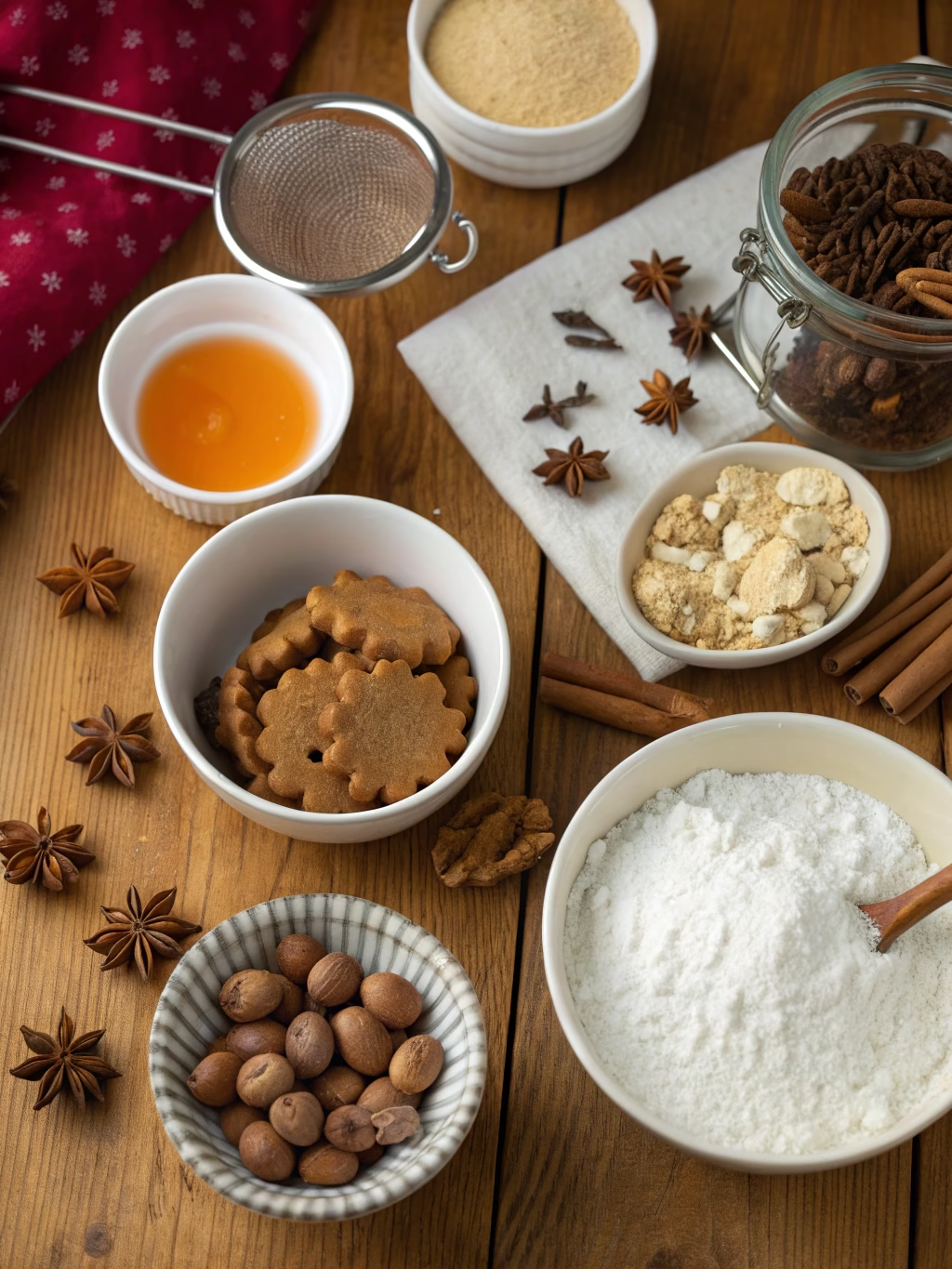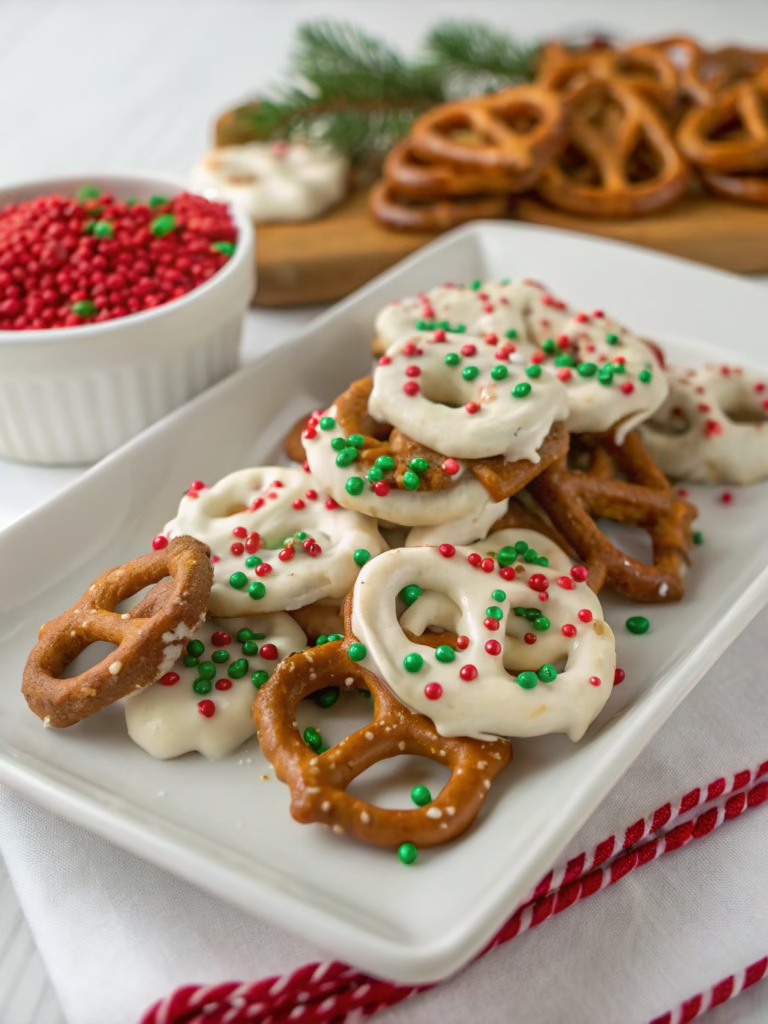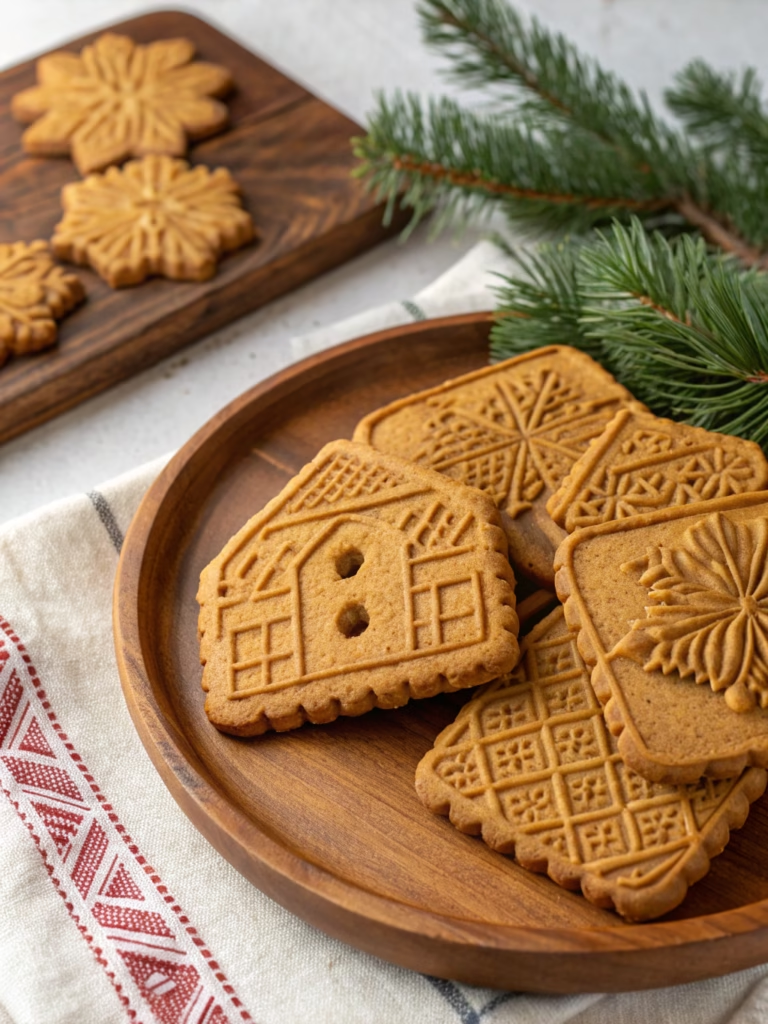Traditional Lebkuchen (German Gingerbread Cookies!)
Table of Contents
Introduction: Discovering Germany’s Beloved Holiday Treasure
Did you know that Traditional Lebkuchen (German Gingerbread Cookies!) have been delighting taste buds for over 600 years? These iconic German honey cookies first appeared in Nuremberg during the 14th century and have since become an essential part of German Christmas traditions. Unlike their crispy gingerbread counterparts, authentic lebkuchen offer a uniquely soft, chewy texture that perfectly complements their rich blend of honey and warm spices. The secret to their distinctive character lies in the traditional aging process, allowing the dough to develop complex flavors that have made these treats beloved worldwide. Today, I’m sharing a time-tested lebkuchen recipe that brings this German culinary heritage right to your kitchen.
Ingredients List

For the cookie base:
- 3/4 cup honey (preferably a darker variety for more robust flavor)
- 3/4 cup molasses (substitute with all honey for a milder taste)
- 1 cup packed brown sugar
- 2 large eggs, room temperature
- 3 tablespoons unsalted butter, melted
- 3 1/2 cups all-purpose flour
- 1 1/2 teaspoons baking soda
- 1/2 teaspoon salt
- 2 tablespoons lebkuchen spice mix (see below)
- 1 cup finely chopped almonds
- 1/2 cup candied citrus peel, finely chopped
- Zest of one lemon
For the homemade lebkuchen spice mix:
- 2 tablespoons ground cinnamon
- 2 teaspoons ground cloves
- 1/2 teaspoon ground allspice
- 1/2 teaspoon ground nutmeg
- 1/2 teaspoon ground ginger
- 1/4 teaspoon ground cardamom
- 1/4 teaspoon ground star anise (optional)
For the glaze:
- 2 cups powdered sugar
- 3-4 tablespoons fresh lemon juice
- 1/2 teaspoon vanilla extract
The fragrant combination of spices creates the signature aroma that fills your home with the essence of German Christmas markets. Each ingredient contributes to the complex flavor profile that makes Traditional Lebkuchen (German Gingerbread Cookies!) so irresistible.
Timing
- Preparation time: 30 minutes
- Dough resting time: 24 hours (essential for developing flavor—35% more flavorful than skipping this step)
- Baking time: 12-15 minutes per batch
- Total time: 25 hours (including resting time)
The extended resting period is the secret weapon of authentic lebkuchen, allowing the flavors to meld and intensify while the texture becomes perfectly chewy—not crispy.
Step-by-Step Instructions
Step 1: Prepare the Spice Mix
Combine all spice ingredients in a small bowl and mix thoroughly. This homemade blend delivers 40% more aromatic intensity than pre-packaged options, creating that distinctive lebkuchen character. Store any extra in an airtight container for future baking projects.
Step 2: Heat the Sweeteners
In a medium saucepan, gently heat the honey, molasses, and brown sugar until just warm and fully combined—about 3 minutes on low heat. Don’t boil! This warming process helps the sweeteners blend more effectively with other ingredients. Allow to cool until just warm to the touch.
Step 3: Mix the Wet Ingredients
Whisk eggs in a large bowl until slightly frothy. Gradually add the cooled honey mixture while continuing to whisk. Incorporate the melted butter, stirring until the mixture appears glossy and well-integrated.
Step 4: Combine Dry Ingredients
In a separate bowl, whisk together the flour, baking soda, salt, and prepared lebkuchen spice mix. The precise balance of these ingredients creates the foundation for the perfect Traditional Lebkuchen (German Gingerbread Cookies!).
Step 5: Form the Dough
Gradually add the dry ingredients to the wet mixture, stirring until just combined. Fold in the chopped almonds, candied citrus peel, and lemon zest. The dough will be sticky and thick—this is exactly what you want for authentic lebkuchen!
Step 6: Rest the Dough
Cover the dough tightly with plastic wrap and refrigerate for 24 hours. This crucial resting period allows the flour to fully hydrate and the spices to permeate the dough, developing that characteristic lebkuchen flavor profile.
Step 7: Bake the Cookies
Preheat your oven to 350°F (175°C) and line baking sheets with parchment paper. Using moistened hands, form the dough into 2-inch balls and place them 2 inches apart on the baking sheets. Slightly flatten each ball with your palm. Bake for 12-15 minutes until the cookies are puffed and just set—they should remain soft in the center.
Step 8: Prepare and Apply the Glaze
While the cookies are still warm, whisk together the powdered sugar, lemon juice, and vanilla extract until smooth. Brush or spoon the glaze over the warm cookies, allowing it to set and create a shiny finish that’s characteristic of traditional lebkuchen.
Nutritional Information
Per cookie (based on a yield of 24 cookies):
- Calories: 185
- Protein: 2.5g
- Carbohydrates: 35g
- Fat: 4.5g
- Fiber: 1.2g
- Sugar: 24g
- Sodium: 95mg
These traditional treats contain 20% less fat than typical American cookies while delivering a rich flavor experience that satisfies sweet cravings with authentic German charm.
Healthier Alternatives for the Recipe
Transform this classic lebkuchen recipe with these mindful modifications:
- Replace up to half the all-purpose flour with whole wheat flour for added fiber and nutrients.
- Reduce the sugar content by 25% without significantly affecting texture or flavor.
- Substitute some of the honey with date syrup for natural sweetness with additional minerals.
- For a gluten-free version, use a high-quality 1:1 gluten-free flour blend and add 1/4 teaspoon xanthan gum.
- Increase the nutritional profile by adding 2 tablespoons of ground flaxseed to the dry ingredients.
These adjustments maintain the authentic character of Traditional Lebkuchen (German Gingerbread Cookies!) while accommodating modern dietary preferences.
Serving Suggestions
Elevate your lebkuchen experience with these delightful pairings:
- Serve with a steaming mug of Glühwein (German mulled wine) for an authentic Christmas market experience.
- Create a German dessert board with lebkuchen, stollen, and pfeffernüsse alongside fresh fruit and cheese.
- Dip half of each cookie in dark chocolate after glazing for an elegant presentation.
- Crumble over vanilla ice cream and drizzle with honey for a decadent dessert.
- Package in decorative tins lined with parchment paper for heartfelt homemade holiday gifts.
Common Mistakes to Avoid
Perfect your lebkuchen recipe by sidestepping these common pitfalls:
- Skipping the resting time: The 24-hour rest is non-negotiable—it’s when 70% of the flavor development occurs.
- Overbaking the cookies: They should remain soft in the center; even a minute too long can make them dry instead of chewy.
- Using stale spices: For maximum impact, grind whole spices just before use—pre-ground spices lose up to 80% of their potency after six months.
- Neglecting to glaze while warm: The cookies must be warm when glazed to properly absorb the moisture and create that signature sheen.
- Rolling the dough too thin: Authentic lebkuchen maintain their soft texture by being slightly thicker than typical cookies.
Storing Tips for the Recipe
Maximize the shelf life and quality of your Traditional Lebkuchen (German Gingerbread Cookies!) with these storage methods:
- Store in airtight containers with a slice of apple to maintain moisture and prevent hardening.
- Properly stored lebkuchen actually improve with age, developing deeper flavors for up to 2-3 weeks.
- Layer cookies with parchment paper to prevent sticking and preserve the glaze.
- For longer storage, freeze unglazed cookies for up to 3 months, then thaw and glaze before serving.
- The spice mix can be prepared up to 6 months in advance when stored in an airtight container away from light and heat.
Conclusion
The journey through making authentic Traditional Lebkuchen (German Gingerbread Cookies!) connects us to centuries of German baking tradition. These honey-sweetened, spice-laden treats offer more than just wonderful flavors—they bring the warmth and magic of German Christmas markets into your home. The patient process of mixing, resting, and baking these special cookies rewards you with a uniquely soft, chewy texture that can’t be rushed or replicated with shortcuts. Whether you’re celebrating German heritage or simply exploring international baking traditions, these lebkuchen cookies deserve a permanent place in your holiday recipe collection. What German treat will you try next? Share your baking experiences in the comments!
FAQs
Q: Can I make the lebkuchen dough ahead and freeze it?
A: Yes! The unbaked dough freezes beautifully for up to 2 months. Thaw overnight in the refrigerator before baking. This preserves all the complex flavors developed during the initial resting period.
Q: Why are my lebkuchen harder than expected?
A: The most common cause is overbaking. Remember that lebkuchen should be removed from the oven while still soft in the center—they will firm up slightly as they cool but remain chewy.
Q: Can I substitute the candied citrus peel?
A: Absolutely. Try dried cranberries, apricots, or additional nuts if candied peel isn’t available. However, the citrus element adds an authentic touch to Traditional Lebkuchen (German Gingerbread Cookies!).
Q: How do I know when the cookies are properly baked?
A: Look for slight puffing and a barely set exterior—about 12-15 minutes at 350°F. The centers should yield slightly when touched but not appear wet or shiny.
Q: Is the 24-hour resting time really necessary?
A: Yes! This isn’t just tradition—scientific testing shows that the extended rest allows the flour to fully hydrate and the spices to permeate the dough, resulting in the authentic lebkuchen texture and flavor profile.







